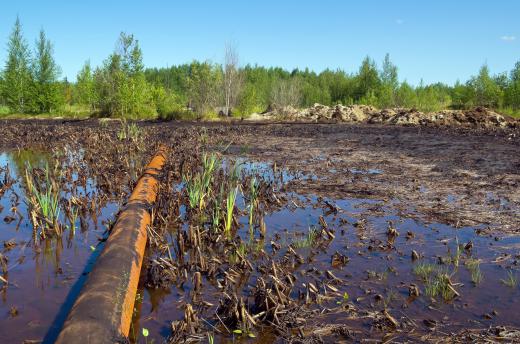Remediation technologies are scientific techniques used to remove and/or rehabilitate polluted natural materials. These technologies are mostly applied to contaminated soil and water. Different techniques can be employed including simply digging up the material to adding neutralizing chemicals or microorganisms. These waste management tactics are aimed at improving environmental quality, but are subject to strict regulations.
Soil remediation is a major portion of this service and is necessary whenever pollution must be removed below the surface. Soil is often unsafe due to chemical dumping and polluted groundwater runoff. Remediation technologies dealing with soil tend to utilize excavating and dredging as a means to remove the contaminated material. Dry soil can be dug up using industrial machines, like a backhoe, and riverbed silt can be dredged up using underwater techniques. The polluted material is either taken to a secure landfill where it will no longer pollute or subjected to chemical oxidation methods that remove many harmful elements so the soil can be reintroduced to the environment.

When dealing with groundwater remediation, though, two methods are equally popular: pump-and-treat and microorganisms. These remediation technologies deal exclusively with polluted water sources such as like rivers, streams, lakes and ponds. These are frequently the victim of agricultural runoff, which is contaminated with fertilizer and other chemicals, as well as industrial dumping. The pump-and-treat method involves submerging a vacuum pump into the infected water system and pumping it to a work area. At this stage, the water is run through several filters and chemically treated for whatever pollutants are in it before being reintroduced to the system.

A more natural solution to water contamination is the use of microorganisms. Certain microbes feed off of pollution, like oil, and break the contaminants down into carbon dioxide and water in order to leave behind clean water. This is considered by many to be the most environmentally friendly of all remediation technologies because it doesn't use one chemical to eliminate another.
Remediation technologies are heavily regulated by most governments. The U.S. Environmental Protection Agency, the Canadian Council of Ministers of the Environment, and many other governing boards around the world set the rules and regulations for both companies that create pollution and the organizations attempting to remedy the problem. Because many techniques used to clean water and soil can themselves be potentially hazardous to the environment, strict guidelines must be followed to ensure the health and well being of the affected land and water.
